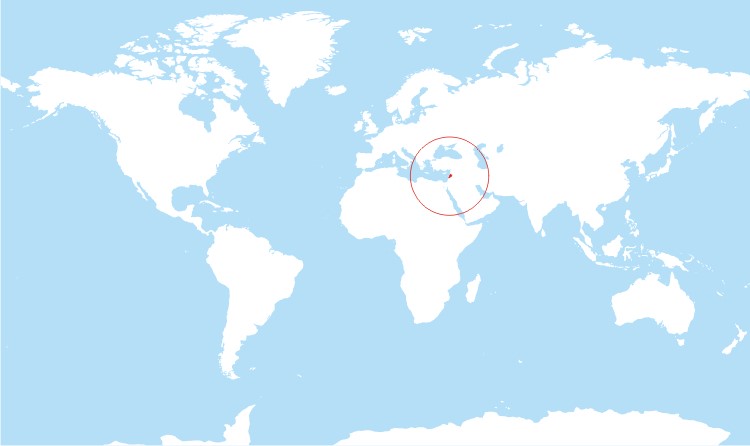
Customs and Cuisine of Lebanon
By Vinola V. Munyon
What’s in a Name?
A country in Western Asia, Lebanon straddles two regions of the world, the Middle East and the Mediterranean, both in terms of location and its cultural identity. Bounded by Syria to the north and east and Israel to the south, Lebanon is one of the smallest countries in continental Asia. Lebanon has the distinction of being one of the regions of the world where civilization predates recorded history.
The Canaanite-Phoenicians, a maritime culture, was one of the earliest recorded inhabitants of Lebanon and are credited with naming the mountain range Mount Lebanon, meaning snow in Phoenician (Loubnan = white). With the passage of time, the country came to be known by the name of the mountains.
Lebanon’s size belies its history and its cultural impact on the world. It has a long and rich legacy of being the home of different civilizations including the Canaanite-Phoenicians, the Assyrians, the Persians, the Greeks, the Romans, the Arabs, the Fatimids, the Crusaders, the Ottoman Turks, and the French. Initially a colony of the Ottoman empire, Lebanon would be under French rule until its independence in 1943. Lebanon enjoyed relative peace under the confessionalist form of government until 1975 when civil war broke out among the various sectarian groups. The civil war would bleed into a period of armed occupation by Syria and Israel, a cause of much violence and unrest in the country.
During the period of peace and economic prosperity in the 1950s, Lebanon came to be known as the “Switzerland of the East.” The influx of tourists into Beirut, the capital of Lebanon, which became a popular travel destination around the same period would earn it the title “Paris of the Middle East.”
The People
The population estimate for July 2020 for Lebanon was 5.6 million with most of the population clustered along the Mediterranean coast and in the urban centers in and around Beirut. While Arab is considered the major ethnic group constituting 95 percent of the population, Lebanese Christians do not self-identify as Arabs preferring instead to go by their Phoenician roots. Despite its location and history, Lebanon is religiously diverse. Based on estimates from 2018, about 61.1 percent identify as Muslim and are about equally divided between the Sunni (30.6 percent) and the Shia (30.5 percent) faiths. About 33.7 percent identify as Christians. Among Christians, the Maronite Catholics are the largest Christian group followed by the Greek Orthodox. A few identify as Jews, Baha’is, Buddhists, and Hindus. This estimate of religious affiliation does not include the Syrian and Palestinian refugee populations in Lebanon.
Religion is a way of life in Lebanon and religious identity is closely tied to social identity as the national ID cards specify religious affiliation. There are 18 sects recognized within the Muslim and Christian religions and each sect is considered a community. Seats in parliament were portioned to reflect religious composition the current ratio being 1:1 for Christian and Muslim and eight seats being reserved for the Druze faith.
The Druze are an ethno-religious community with their belief system rooted in the Abrahamic tenets of the Islamic faith. It differs from Islam in its non-adherence to the Five Pillars of Islam and the non-observance of Ramadan and the adherence to some other philosophical beliefs. Considered directly descended from an “inaugurated” group, one can adhere to the faith only through birth. Conversion into or out of the faith is traditionally disallowed.
The female life expectancy (79.8 years) is a little higher than males (76.9) and the fertility rate is at 1.71 children per female.
The official language is Arabic with French being the language that is next in prevalence of use. About 70 percent of schools in Lebanon use French as the secondary language of instruction and about 40 percent of the population are considered Francophone (French-speaking). English and Armenian are other languages in use.
Lebanon is home to and source of refugees and Internally displaced persons. About 916,248 Syrian refugees, 475,075 Palestinian refugees, and 11,000 internally displaced persons call Lebanon home. Its location makes Lebanon a transit and destination country for human trafficking and for trade in illicit drugs. Human trafficking often takes the form of forced labor wherein women recruited from parts of Asia and the Middle East under the guise of being offered domestic work are often forced into bonded labor, or it takes the form of sex trafficking wherein young girls and women lured with promises of work in the entertainment industry are trafficked for the sex industry instead.
The Family Unit
Lebanon is predominantly urban with about 88.9 percent of total population (2020) living in urban areas. About half the population, 2.424 million, live in and around the capital city, Beirut.
As is with some Asian and Middle Eastern cultures, Lebanon is a collectivistic culture. The needs of the collective are valued over that of the individual. The basic collective unit is the family and as such family reigns supreme. While there are variations in adherence to traditional values among the Lebanese who live in the cities and those who have lived abroad and returned versus those who live in the more rural regions and also on the basis of religious affiliations, the importance of family is considered a fundamental and inalterable value.
The household structure is patriarchal, and traditionally children live with the parents until they get married and/start a family a of their own. The elders within the family are afforded revered status and the eldest male in the household is often the voice of authority on matters concerning all members of the household. While the females in the household are entrusted with all things childcare, if divorce is being considered, children are automatically considered to “belong” with the male member of the family. Times are a changing and with the changing times women are increasingly a part of the workforce but within the household, power still rests among the males.
Traditionally, the typical family is an extended multi-generational family with cousins being as close-knit as siblings in some individualistic cultures. Elder care facilities and nursing homes are a rarity as the elders in the family are often cared for by the younger members within the family. Arranged marriages were the norm with unions being arranged on the basis of compatibility of socioeconomic statuses and religious affiliation and this is still followed in some circles. However, unions based on love are more common in today’s Lebanon.
The Food of Lebanon
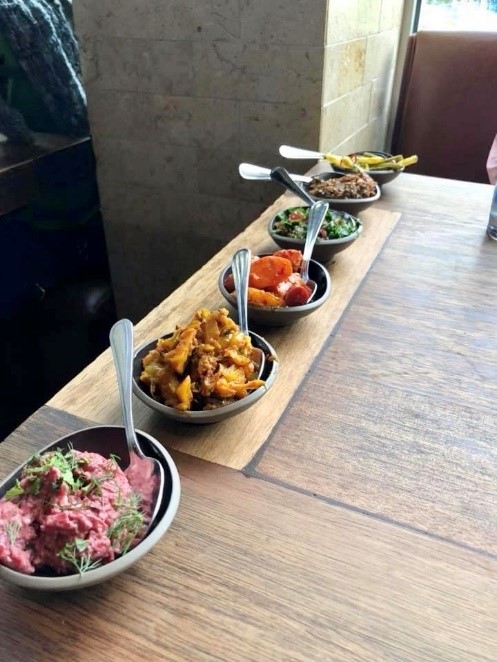
Mezze of pickled and seasoned vegetables
Lebanese cuisine is a harmonious mix of Mediterranean, middle eastern, and French cuisines with the Mediterranean influence being the most prominent. The diet is heavy in grains, legumes, vegetables, fruits, and nuts. Olive oil and garlic are essential ingredients in the preparation of almost every dish. The primary animal-based proteins are lamb, chicken, and beef, in that order. The method of preparation usually involves grilling, baking, and to a lesser extent sautéing. Flavor is imparted to the food through fresh spices and copious amounts of fresh herbs. Despite the French influences in its history and in the popularity of croissants and flan, Lebanese food rarely involves the use of elaborate sauces, cream, or even butter in its cuisine.
Food is served “meze” style wherein a group of 4 – 6 small plate dishes are served in a course. The dishes in each meze complement each other and are part of a pattern. While we may not associate some of these dishes (hummus, tabbouleh, pita bread, kebab, etc.) with Lebanon per se, they are definitely becoming part of the vernacular of what is broadly considered Mediterranean food in the United States and in other Western Countries.
Hummus, the dip made of chickpeas pureed with tahini paste, olive oil, and seasonings, is a common dish in Lebanon. Topped with a drizzle of olive oil and pine nuts and sometimes ground meat such as lamb, Hummus is often served with warm pita bread.
Baba Ghanouj, a dip of mashed roasted eggplants mixed with tahini paste, garlic, and white vinegar (if one is looking to lighten the color), is a popular cold appetizer dip served along with along with pita bread.
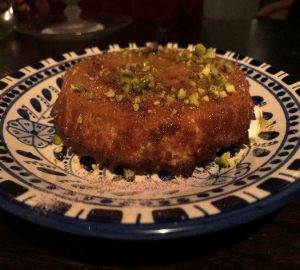
Kanafeh
“Kibbeh” is the national dish of Lebanon. A pâté-like paste of finely ground lamb, bulgur wheat, and seasonings, kibbeh can be served in many forms. It can be served raw as “Kibbeh Nayee” which is akin to a pâté or tartare of sorts. It can be shaped into little ovals, fried, and served as “Kibbeh Rass,” or baked and served as “Kibbeh Bil-Saneeya.” Cooked Kibbeh is usually served with garlic or lemony yogurt dip.
“Shawarma” (Turkish, çevirme= turning) is a vertical spit-roasted, marinated, and seasoned ground meat (typically lamb or chicken) that is then thinly sliced. The shawarma is typically served as a wrap sandwich with garlic paste or tahini, tomatoes, parsley, cucumber, etc.
“Mujardara” is a traditional rich lentil one-pot dish, always served garnished with a heaping amount of browned, caramelized onions.
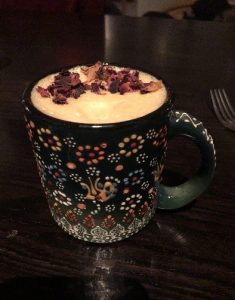
Kahweh with milk and rose petals
Bread in the form of pita bread is a staple at every meal. Known as “esh” in some Arabic dialects, it literally translates to “life.” Drizzled with olive oil or sprinkled with za’atar (a combination of toasted za’atar, dried thyme, sumac, and sesame seeds), freshly baked pita bread is, like garlic and olive oil, a quintessential part of a Lebanese meal.
“Baklava” is a popular dessert. Baklava of Lebanese cuisine differs from Greek baklava in that Lebanese baklava contains pistachio and the simple syrup is rose flavored, while Greek baklava has walnuts and a honey-based syrup.
“Kanafeh” is a crunchy phyllo pastry that contains a cheese filling. Hot rose water syrup is poured on the Kanafeh soaking the pastry and melting the cheese.
“Kahweh” Coffee is served strong, black, and sometimes perfumed with cardamom.
The Lebanese Way of Life
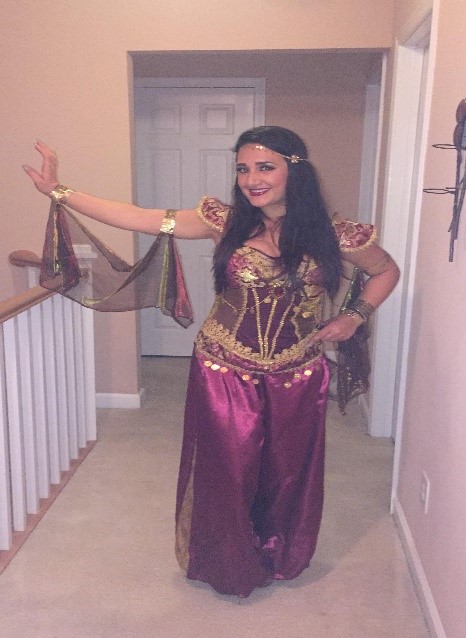
Dressed in the traditional “Oriental Dabke” dance wear
The
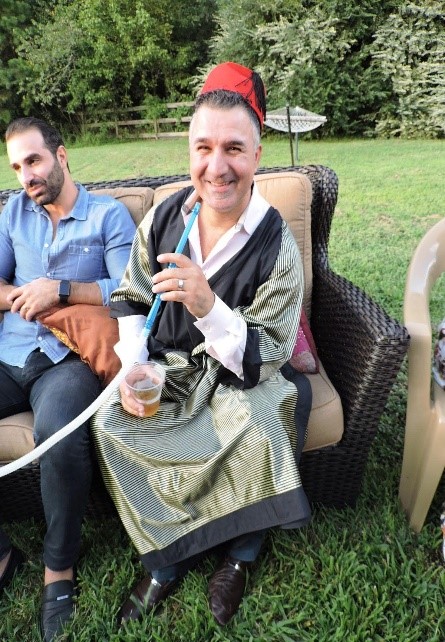
Dressed in the traditional “tarboush” and smoking the “Arguile”
Lebanese way of life is the product of traditional values and cosmopolitan ways of life and as such, it is ever evolving. This plurality is reflected in every walk of life. It is not uncommon to see women in traditional Islamic veiled garb walking in step with women dressed in the latest trends in the Western world. The pace of everyday life is slow and unhurried, with the Lebanese often being fashionably late to any gathering. However, the civil war, military occupations, and the specter of the fleeting nature of life has imparted conversely a frenetic partying, an enjoying of culture and food and entertainment in a “seize the day” sort of way.
Honor and family are considered touchstones of the national culture. Though there is a less strict adherence to the rigid ways of living that ensured that one did “not lose face” it remains an undercurrent in the ways of life and living among the Lebanese. The interests of one’s primary group, the family, almost always supersede those of the individual.
The Lebanese are known to be boisterous and affectionate; they often address one another as “habibi” meaning “my love.” They are also a deeply loyal and giving people.
Sources:
Picture credits: Vinola Vincent Munyon and Murielle Hage
References:
https://culturalatlas.sbs.com.au/lebanese-culture/lebanese-culture-core-concepts
https://www.everyculture.com/Ja-Ma/Lebanon.html
https://www.cia.gov/library/publications/the-world-factbook/geos/le.html
https://www.mamaslebanesekitchen.com
http://www.foodbycountry.com/Kazakhstan-to-South-Africa/Lebanon.html
View Recipes from Lebanon
Lebanon
